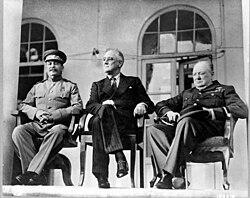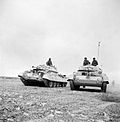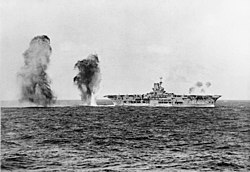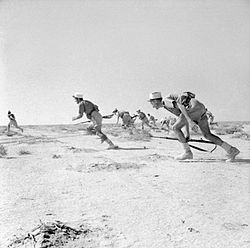Allies of World War II
The Allies, (formally referred to as the United Nations from 1942-1945) were a group of nations that fought against the Axis countries in World War II. They were successful in defeating the Axis nations. The war ended in 1945. The group of nations was later named the United Nations by U.S. President Franklin Roosevelt. The main great powers, sometimes called "The Big Three", were the United Kingdom, the United States, and the Soviet Union. Sometimes China was added to the list, making a "Big Four".
Allies of World War II | |||||||
|---|---|---|---|---|---|---|---|
| 1939–1945 | |||||||
| Anthem: | |||||||
 A 1943 poster showing the flags of many of the members of the Allies, including the "Big Three"
The Big Four:
Full list | |||||||
| Status | Military alliance | ||||||
| Historical era | World War II | ||||||
| February 1921 | |||||||
• | August 1939 | ||||||
| September 1939 – June 1940 | |||||||
| June 1941 | |||||||
| July 1941 | |||||||
| August 1941 | |||||||
| January 1942 | |||||||
| May 1942 | |||||||
| November–December 1943 | |||||||
| 1–15 July 1944 | |||||||
| 4–11 February 1945 | |||||||
| April–June 1945 | |||||||
• | July–August 1945 | ||||||
| |||||||
1939-1941
Poland was invaded by Germany on 1 September 1939, so Britain and France declared war two days later.
Many more countries joined the alliance after Germany invaded them. France fell after a German invasion from May - June 1940 and a puppet state was put in place, so the British and the remaining forces of the exiled governments later invaded the Vichy french territories. These freed lands were called Free France
Germany invaded the Soviet Union on 22 June 1941 and the Soviets allied with the British and the other allies.
The United States joined the war after the Japanese bombed Pearl Harbor.
Declaration by the United Nations
The alliance was formalised in the Declaration by United Nations signed on 1 January 1942. There were the 26 original signatories of the declaration; the Big Four were listed first:
Major Allied Powers
Other Allied Powers
- File:Flag of Albania (1944–1946).svg Albania
 Australia
Australia Belgium
Belgium- 22x20px Brazil
 Canada
Canada- File:Flag of Cuba.svg Cuba
- File:Flag of the Czech Republic.svg Czechoslovakia
 Dominican Republic
Dominican Republic- 22x20px Ethiopia
- File:State Flag of Greece (1863-1924 and 1935-1973).svg Greece
- File:Flag of Luxembourg.svg Luxembourg
 Mexico
Mexico Netherlands
Netherlands New Zealand
New Zealand Norway
Norway Poland
Poland Saudi Arabia
Saudi Arabia South Africa
South Africa Yugoslavia
Yugoslavia
Client and occupied states
British
Soviet sphere
Co-belligerent states
1942-1945
Advances in Eastern Europe and North Africa in late 1942 changed the course of the war and continued on other fronts until the war ended. (there were also slow advances in the pacific)
The allies invaded italy in 1943, after driving the axis out of Africa. And so Italy changed sides on 8 September 1943. and with German forces staying, a civil war began.
The Soviet Red Army continued advances against the axis, ending the siege of Leningrad, liberating Crimea, and invading Romania. On June 22 1944, operation Bargration was launched advancing to the Hungarian border and to Warsaw.
Meanwhile in Western Europe, D-Day was launched on June 6 1944 and the allies started advancing rapidly in august.
Romania changed sides in August after the Soviets were advancing. Bulgaria changed sides in September with the Soviets invading. Finland also changed sides in September.
The allies had advances in the Pacific. In the Solomon Islands, in Burma, and other Pacific islands.
On May 7 1945, Germany surrendered after 5 years and 8 months of fighting. In the Pacific, the allied liberated Burma and advanced in China, the Philippines, and Borneo. Atomic bombs were dropped on Japan and around the same time, the Soviets invaded Manchuria (a Japanese puppet state) and Japan surrendered on September 2 1945, ending World War II.
United Nations
The United Nations was formed on 24 October 1945, with France, China, The United Kingdom, The United States, and The USSR as the five permanent members of the United Nations Security Council (which met for the first time on 17 January 1946).
Members
These are the original 51 signatories (UNSC permanent members are asterisked):
- 23x15px Argentine Republic
 Commonwealth of Australia
Commonwealth of Australia Kingdom of Belgium
Kingdom of Belgium Republic of Bolivia
Republic of Bolivia- 23x15px United States of Brazil
- File:Flag of the Byelorussian Soviet Socialist Republic (1937–1951).svg Byelorussian Soviet Socialist Republic
- File:Flag of Canada (1921–1957).svg Dominion of Canada
 Republic of Chile
Republic of Chile Republic of China*
Republic of China* Republic of Colombia
Republic of Colombia Republic of Costa Rica
Republic of Costa Rica Republic of Cuba
Republic of Cuba Czechoslovak Republic
Czechoslovak Republic Kingdom of Denmark
Kingdom of Denmark Dominican Republic
Dominican Republic Republic of Ecuador
Republic of Ecuador- Template:Country data Kingdom of Egypt Kingdom of Egypt
 Republic of El Salvador
Republic of El Salvador- 23x15px Ethiopian Empire
 French Republic*
French Republic* Kingdom of Greece
Kingdom of Greece Republic of Guatemala
Republic of Guatemala Republic of Haiti
Republic of Haiti- 23x15px Republic of Honduras
 British Raj
British Raj- File:State flag of Iran (1933–1964).svg Imperial State of Iran
- Template:Country data Kingdom of Iraq Kingdom of Iraq
 Lebanese Republic
Lebanese Republic Republic of Liberia
Republic of Liberia Grand Duchy of Luxembourg
Grand Duchy of Luxembourg- File:Flag of Mexico (1934-1968).svg United Mexican States
 Kingdom of the Netherlands
Kingdom of the Netherlands Dominion of New Zealand
Dominion of New Zealand Republic of Nicaragua
Republic of Nicaragua Kingdom of Norway
Kingdom of Norway Republic of Panama
Republic of Panama Republic of Paraguay
Republic of Paraguay Republic of Peru
Republic of Peru Commonwealth of the Philippines
Commonwealth of the Philippines- Template:Country data Provisional Government of National Unity Republic of Poland
 Kingdom of Saudi Arabia
Kingdom of Saudi Arabia Union of South Africa
Union of South Africa- File:Flag of Syria (1930–1958, 1961–1963).svg Syrian Republic
 Republic of Turkey
Republic of Turkey Ukrainian Soviet Socialist Republic
Ukrainian Soviet Socialist Republic Union of Soviet Socialist Republics*
Union of Soviet Socialist Republics* United Kingdom of Great Britain and Northern Ireland*
United Kingdom of Great Britain and Northern Ireland* United States of America*
United States of America* Oriental Republic of Uruguay
Oriental Republic of Uruguay- 23x15px United States of Venezuela
 Democratic Federal Yugoslavia
Democratic Federal Yugoslavia
Summary table
The Big Four
Allied combatants with governments-in-exile
Other Allied combatant states
 Canada
Canada Australia
Australia New Zealand
New Zealand India
India South Africa
South Africa Southern Rhodesia
Southern Rhodesia Newfoundland
Newfoundland Burma
Burma Nigeria
Nigeria Malta
Malta- Template:Country data British Ceylon
- 22x20px Brazil
 Mexico
Mexico- Template:Country data Mongolian People's Republic
- Template:Country data Kingdom of Egypt
 Cuba
Cuba- 22x20px Argentina
 Nepal
Nepal Liberia
Liberia Iran
Iran Saudi Arabia
Saudi Arabia Turkey
Turkey Chile
Chile Colombia
Colombia Ecuador
Ecuador Peru
Peru Bolivia
Bolivia Uruguay
Uruguay- 22x20px Venezuela
 Costa Rica
Costa Rica Panama
Panama Haiti
Haiti Honduras
Honduras Dominican Republic
Dominican Republic Nicaragua
Nicaragua El Salvador
El Salvador Guatemala
Guatemala Oman
Oman French Indochina
French Indochina Dutch East Indies
Dutch East Indies Syria
Syria Lebanon
Lebanon
Former Axis powers
- Template:Country data Kingdom of Iraq (from January 1943)
- 22x20px Italy (from September 1943)
 Romania (from August 1944)
Romania (from August 1944) Bulgaria (from September 1944)
Bulgaria (from September 1944) Finland (from September 1944)
Finland (from September 1944) Hungary (Debrecen government, 1945)
Hungary (Debrecen government, 1945)
Cold War
Despite the successful creation of the United Nations, the alliance of the Soviet Union with the United States and with the United Kingdom ultimately broke down and evolved into the Cold War, which took place over the following half-century.
Timeline of allied nations entering the war
The following list denotes dates on which states declared war on the Axis powers, or on which an Axis power declared war on them. The Indian Empire had a status less independent than the Dominions.
1939
 Poland (September 1 1939)
Poland (September 1 1939) France (September 3 1939)
France (September 3 1939) United Kingdom (September 3 1939)
United Kingdom (September 3 1939)
 Australia (September 3 1939)
Australia (September 3 1939) New Zealand (September 3 1939)
New Zealand (September 3 1939) Nepal (September 4 1939)
Nepal (September 4 1939) South Africa (September 6 1939)
South Africa (September 6 1939) Canada (September 10 1939)
Canada (September 10 1939) Oman (September 10 1939)
Oman (September 10 1939)
1940
 Norway (April 8 1940)
Norway (April 8 1940) Denmark (April 9 1940)
Denmark (April 9 1940) Belgium (May 10 1940)
Belgium (May 10 1940) Luxembourg (May 10 1940)
Luxembourg (May 10 1940) Netherlands (May 10 1940)
Netherlands (May 10 1940) Greece (October 28 1940)
Greece (October 28 1940)
1941
 Yugoslavia (April 6 1941)
Yugoslavia (April 6 1941) Soviet Union (June 22 1941)
Soviet Union (June 22 1941) Panama (December 7 1941)
Panama (December 7 1941) United States (December 8 1941)
United States (December 8 1941)
 Costa Rica (December 8 1941)
Costa Rica (December 8 1941) Dominican Republic (December 8 1941)
Dominican Republic (December 8 1941) El Salvador (December 8 1941)
El Salvador (December 8 1941) Haiti (December 8 1941)
Haiti (December 8 1941) Honduras (December 8 1941)
Honduras (December 8 1941) Nicaragua (December 8 1941)
Nicaragua (December 8 1941) China (December 9 1941)
China (December 9 1941) Cuba (December 9 1941)
Cuba (December 9 1941) Guatemala (December 9 1941)
Guatemala (December 9 1941)
Provisional governments or governments-in exile that declared war against the Axis in 1941
 Provisional Government of the Republic of Korea (December 10 1941)
Provisional Government of the Republic of Korea (December 10 1941) Czechoslovakia (government-in-exile) (December 16 1941)
Czechoslovakia (government-in-exile) (December 16 1941)
1942
1943
- Template:Country data Kingdom of Iraq (January 16 1943) - former axis power
 Bolivia (April 7 1943)
Bolivia (April 7 1943) Colombia (July 26 1943)
Colombia (July 26 1943) Iran (September 9 1943)
Iran (September 9 1943) Italy (October 10 1943) - former axis power
Italy (October 10 1943) - former axis power
1944
1945
 Ecuador (February 2 1945)
Ecuador (February 2 1945) Paraguay (February 7 1945)
Paraguay (February 7 1945) Peru (February 12 1945)
Peru (February 12 1945) Uruguay (February 15 1945)
Uruguay (February 15 1945)- 22x20px Venezuela (February 15 1945)
 Turkey (February 23 1945)
Turkey (February 23 1945)- Template:Country data Kingdom of Egypt (February 24 1945)
 Syria (February 26 1945)
Syria (February 26 1945) Lebanon (February 27 1945)
Lebanon (February 27 1945) Saudi Arabia (March 1 1945)
Saudi Arabia (March 1 1945) Finland (March 3 1945) - former ally of Germany in the Continuation War. Finland retroactively declared war on Germany from 15 September 1944.
Finland (March 3 1945) - former ally of Germany in the Continuation War. Finland retroactively declared war on Germany from 15 September 1944.- 22x20px Argentina (March 27 1945)
 Chile (April 11 1945)
Chile (April 11 1945) Mongolia (August 10 1945)
Mongolia (August 10 1945)
Allies Of World War II Media
The Allied leaders of the European theatre (left to right): Joseph Stalin, Franklin D. Roosevelt and Winston Churchill meeting at the Tehran Conference in 1943
The Allied leaders of the Pacific War: Chiang Kai-shek, Franklin D. Roosevelt, and Winston Churchill meeting at the Cairo Conference in 1943
Queen Elizabeth and Princess Elizabeth talking to paratroopers in preparation of D-Day, 19 May 1944
British Supermarine Spitfire fighter aircraft (bottom) flying past a German Heinkel He 111 bomber aircraft (top) during the Battle of Britain in 1940
British Crusader tanks during the North African Campaign
British aircraft carrier HMS Ark Royal under attack from Italian aircraft during the Battle of Cape Spartivento (27 November 1940)
British soldiers of the King's Own Yorkshire Light Infantry in Elst, Netherlands on 2 March 1945
Free French forces at the Battle of Bir Hakeim, 1942
References
- ↑ France declared war on Germany on 3 September 1939, two days after the German invasion of Poland. It was a member of the Allies until its defeat in the German invasion of France in June 1940. Unlike the other governments-in-exile in London, which were legitimate governments that had escaped their respective countries and continued the fight, France had surrendered to the Axis. The "Free French Forces" were a section of the French army which refused to recognize the armistice and continued to fight with the Allies. They worked towards France being seen and treated as a major allied power, as opposed to a defeated and then liberated nation. They struggled with legitimacy vis-a-vis the German client state "Vichy France", which was the internationally recognized government of France even among the Allies. A National Liberation Committee was formed by the Free French after the gradual liberation of Vichy colonial territory, which led to the full German occupation of Vichy France in 1942. This started a shift in Allied policy from trying to improve relations with the Vichy regime into full support to what was now the Provisional Government of the French Republic.
- ↑ The Polish Underground State was allied with United Kingdom and United States. It fought against Axis Powers (mostly Germany), Soviet Union and the Polish Committee of National Liberation (PKWN). However the PKWN was allied with the Soviet Union and fought against Germany and the Polish Underground State.
- ↑ Edvard Beneš, president of the First Czechoslovak Republic, fled the country after the 1938 Munich Agreement saw the Sudetenland region annexed by Germany. In 1939 a German sponsored Slovak Republic seceded from the post-Munich Second Czechoslovak Republic, providing justification for the establishment of a German protectorate over the remaining Czech lands (the rump Carpathian Ruthenia region being annexed by Hungary). Following the outbreak of war later the same year, Beneš, in his exile, formed a Czechoslovak National Liberation Committee which after some months of negotiations regarding its legitimacy became regarded as the Czechoslovak government-in-exile by the Allies.
- ↑ The Ethiopian Empire was invaded by Italy on 3 October 1935. On 2 May 1936, Emperor Haile Selassie I fled into exile, just before the Italian occupation on 7 May. After the outbreak of World War II, the United Kingdom recognized Haile Selassie as the Emperor of Ethiopia in July 1940 and his Ethiopian exile government cooperated with the British during their invasion of Italian East Africa in 1941. Through the invasion Haile Selassie returned to Ethiopia on 18 January, with the liberation of the country being completed by November the same year.













